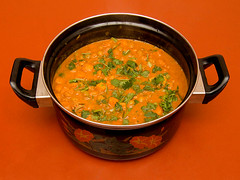Curry (from Tamil, one of the languages of Southern India) is the English description of any of a general variety of spicy dishes, says wikipedia.
Curry is most likely an anglicized name for the Kari in Tamil to connotate any secondary dish eaten with rice.
The term curry is now used more broadly, especially in the Western world, to refer to almost any spiced, sauce-based dishes cooked in various south and southeast Asian styles.
Not all curries are made from curry powder.
Commercial spice mixes analagous to curry powder are called Garam masala in Hindi and Nepali.
There is a particular north Indian and Pakistani dish which is given the name curry or kadi and utilizes yoghurt, ghee, and besan. In Northern India and Pakistan, the word "curry" usually means "gravy."
Curry powder, also known as masala powder, is a spice mixture of widely varying composition developed by the British during the Raj as a means of approximating the taste of Indian cuisine at home.
Masala refers to spices, and this is the name given to the thick pasty liquid sauce of combined spices and ghee (clarified butter), butter, palm oil or coconut milk.
Most commercial curry powders available in Britain, the U.S. and Canada rely heavily on ground turmeric, in turn producing a very yellow sauce. Lesser ingredients in these Western yellow curry powders are often coriander, cumin, fenugreek, mustard, chili, black pepper and salt.
It should be reiterated that curry powders and pastes produced and consumed in India are extremely diverse; some red, some yellow, some brown; some with five spices and some with as many as 20 or more.
Thursday, November 01, 2007
Subscribe to:
Post Comments (Atom)


No comments:
Post a Comment